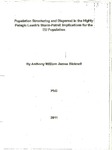Population structuring and dispersal in the highly pelagic Leach's storm-petrel: implications for the EU population
| dc.contributor.supervisor | Votier, Stephen | |
| dc.contributor.author | Bicknell, Anthony William James | |
| dc.contributor.other | Faculty of Science and Engineering | en_US |
| dc.date.accessioned | 2011-09-30T10:00:32Z | |
| dc.date.available | 2011-09-30T10:00:32Z | |
| dc.date.issued | 2011 | |
| dc.identifier | 317822 | en_US |
| dc.identifier.uri | http://hdl.handle.net/10026.1/814 | |
| dc.description.abstract |
Dispersal is a fundamental process that shapes many aspects of population ecology and evolution. Dramatic local population declines brought about by anthropogenic-driven changes to ecological processes are unfortunately becoming ubiquitous and increasing the urgency to understand dispersal behaviour in many species. For species where direct methods of tracking movement and dispersal are unsuitable, other indirect methods need to be employed to understand and characterise these behaviours. The steep population decline, due to predation, at the largest EU population of Leach’s storm-petrels Oceanodroma leucorhoa (St Kilda, Scotland), and the potential part immigrant birds have in buffering this threat, highlighted the need to understand dispersal and connectivity of widely spaced colonies in this species. The implications for the persistence of local colonies and the wider population of Leach’s storm-petrels could then be assessed. A population genetic analysis of 9 colonies across the North Pacific and Atlantic distribution, using two DNA markers (mtDNA control region and microsatellites), revealed ocean basin differentiation (Global ST = 0.32 P <0.0001, Global FST = 0.04, P <0.0001) but also identified a migrant individual in the Pacific population (STRUCTURE migrant assignment). The Atlantic population was found to be genetically homogenous, with patterns of historical and contemporary gene flow, indicating that long-distance effective dispersal is prevalent in Leach’s storm-petrels within the ocean basin. Bayesian stable isotope analysis of carbon and nitrogen (13C & 15N) provides evidence for natal dispersal as an important dispersal mechanism, and reveals movement of immature birds between colonies during the breeding season as a likely mechanism to promote inter-colony exchange and gene flow. Stable isotope comparison also identified mixing on wintering grounds as another possible influence on dispersal. The potential for immigrant birds to offset the loss caused by predation at the St Kilda colony is supported by these studies, and will likely help the persistence of the colony in the short-term. However, future viability is debateable considering the evidence for both avian and mammalian predation. This research provides a better understanding of the extent and mechanism of dispersal in the Leach’s storm-petrel, which is important to predict the potential impact of environmental change and, where possible, implement effective population management for this species. | en_US |
| dc.description.sponsorship | Natural Environment Research Council & Joint Nature Conservation Committee | en_US |
| dc.language.iso | en | en_US |
| dc.publisher | University of Plymouth | en_US |
| dc.subject | Population genetic structure | en_US |
| dc.subject | Leach's storm-petrel | en_US |
| dc.subject | Stable isotope analysis | en_US |
| dc.subject | Dispersal | en_US |
| dc.subject | St Kilda | en_US |
| dc.title | Population structuring and dispersal in the highly pelagic Leach's storm-petrel: implications for the EU population | en_US |
| dc.type | Thesis | |
| dc.identifier.doi | http://dx.doi.org/10.24382/4233 |
Files in this item
This item appears in the following Collection(s)
-
01 Research Theses Main Collection
Research Theses Main


